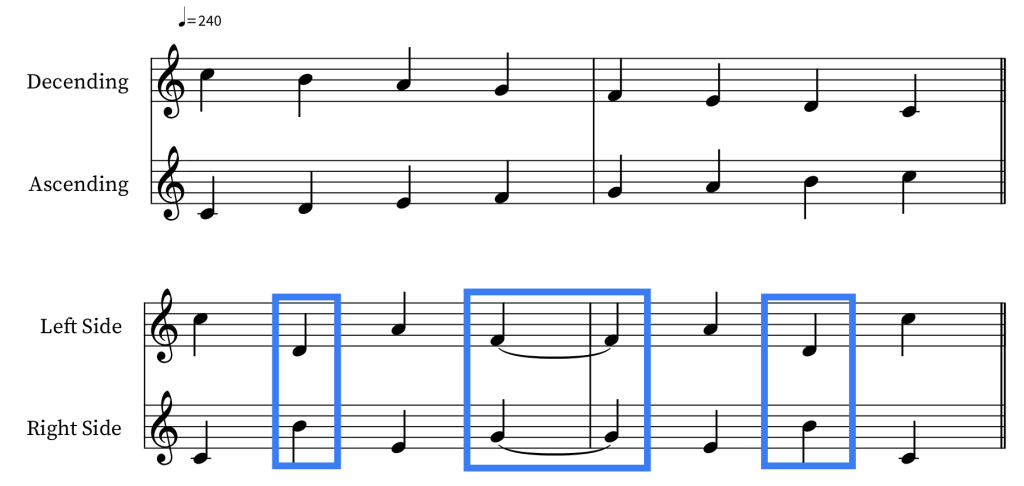9 Acoustics & Perception 101
Our perception of sound is based on the physics behind sound as well as our physiological makeup as human beings. We have already talked about concepts such as “proximity”, “closure” and “common fate” and how they have an impact on how music is composed and heard. As a tangent, let’s look (and listen) to these concepts at work in a different context.
You are probably familiar with optical illusions, but did you know there are also auditory illusions as well? Let’s look and listen to a few…
Musical Illusions
Diana Deutsch is a psychologist who researched audio perception. Her work includes many auditory illusions
Let’s look at one so that as you understand what is happening, you might begin to think on how we hear might influence your upcoming musical and compositional decisions…
Scale Illusion
The Scale Illusion was discovered by Deutsch in 1973, first reported at a meeting of the Acoustical Society of America (1974) and first published in the Journal of the Acoustical Society of America (1975). The pattern that produces the Scale Illusion consists of a major scale with successive tones alternating from ear to ear. The scale is played simultaneously in both ascending and descending form; however when a tone from the ascending scale is in the right ear a tone from the descending scale is in the left ear, and vice versa.[1]
Here is how the audio file is created… left ear starts with a descending major scale and with right ear, an ascending scale. Then every other note is switched between ears (see the blue boxes.)

In the video below, I’ve created a version that plays the scale (1st line), then each modified scale one ear at a time (2nd line), and then finally the full illusion (both parts together).
Scale Illusion Demo
Even though the melodic content in each ear has lots of skips and jumps (is ‘disjunct’) our brain adjusts to provide a more ‘conjunct’ perception – most people will hear the descending part in the left ear, and the more ascending part in the right.
We perceive melody primarily through contour rather than individual pitches, thus our brains try to ‘smooth’ out the contour in this musical illusion.
To further demonstrate the strength of contour, here’s a well-know tune played with the correct pitches, but the contour (shape of the melody) has been inverted.
| Mystery Song (listen to this version first!) | |
| Original Song (in multiple octaves) |
The Power of Experience
Music is obviously an important aspect of your life as partly evidenced by your taking this course! Music in the 21st century is one of the most ubiquitous arts. We make connections across multiple mediums and arts in our digital environments.
Here’s a simple exercise to demonstrate this…
First, here are two made-up words:
- ooloom
- ta-ke-ti
Here are two abstract drawings:


So… which word goes with which picture? Pretty obvious but why? These shapes are pretty abstract (they don’t depict anything in particular) and the words are made up. Even the colors probably seem to agree with the pictures and words.
Listen to these pairs of musical examples… for each example, which would you label as “ooloom” and which as “ta-ke-ti” ?
| Music Excerpt A | |
| Music Excerpt B | |
| Music Excerpt 1 | |
| Music Excerpt 2 |
Questions…
- Describe the musical features used in these excerpts that create a sense of either “ooloom”
- Now describe musical features used that created a sense of “ta-ke-ti”
Assignment: Opus 1: MIDI piece using GM pitched instrument(s) based on reading
Create a midi piece that has two tracks, (one for ooloom, one for ta-ke-ti)
- Track 1: assign a suitable GM instrument and create original content that represents “ooloom”
- Track 2: assign a different GM instrument and create additional content that represents “ta-ke-ti”
NOTE: the two tracks should be considered independent of each other
SUBMISSION: (1) A standard MIDI file (two tracks) and (2) Logic Pro project with description in the notepad
See full Assignment here: OPUS 1: ooloom & ta-ke-ti
